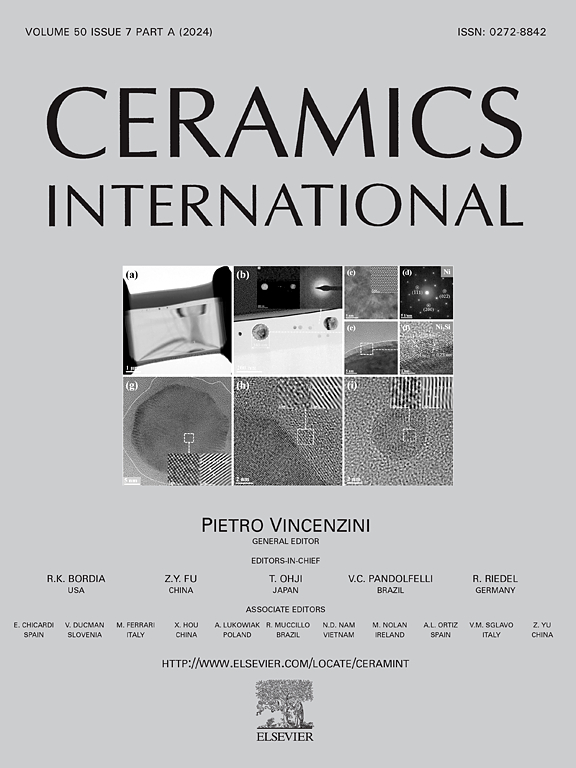Densification and mechanical properties of high-entropy diboride ceramics sintered using Ni activation
IF 5.1
2区 材料科学
Q1 MATERIALS SCIENCE, CERAMICS
引用次数: 0
Abstract
High-entropy diboride ceramics (HEBs) represent a novel and promising category within the realm of ultra-high temperature ceramics (UHTCs). Due to their exceptional performance in extreme service conditions, HEBs have emerged as the preferred choice for thermal structural components and thermal protection systems. However, the robust nature of covalent bonding, coupled with a low self-diffusion coefficient, presents significant challenges for the densification of HEBs. In addition, the inferior fracture toughness of HEBs severely hinders their promotion in large-scale applications as thermal structures and thermal protection materials. Currently, research on HEBs both domestically and internationally is still insufficient. Therefore, there is an urgent need for in-depth studies aimed at improving the densification and fracture toughness of HEBs. In this study, dense (Hf0.2Zr0.2Ti0.2Ta0.2Cr0.2)B2 and (Hf0.2Zr0.2Ti0.2Ta0.2Mo0.2)B2 ceramics were successfully prepared with Ni metal as an additive. It was demonstrated that the incorporation of 10 wt% Ni led to an enhancement in the relative densities of the two HEBs, achieving values of 97.24 % and 96.83 %, respectively. This improvement is likely attributable to the development of a Ni-B based liquid phase during the sintering process, which facilitated the densification of the ceramic by effectively wetting the grain boundaries. The fracture toughness of the two materials also reached maximum values of 6.76 MPa m1/2 and 6.43 MPa m1/2 when the Ni addition was 10 wt%. This enhancement in fracture toughness is attributed to the pinning effect exerted by the dispersed Ni particles within the ceramic matrix, which inhibits crack propagation.
Ni活化法制备高熵二硼化物陶瓷的致密化及力学性能
高熵二硼化物陶瓷(HEBs)是超高温陶瓷(UHTCs)领域中一个新颖而有前途的领域。由于其在极端使用条件下的卓越性能,heb已成为热结构部件和热保护系统的首选。然而,共价键的坚固性,加上较低的自扩散系数,对heb的致密化提出了重大挑战。此外,HEBs断裂韧性较差,严重阻碍了其作为热结构和热防护材料的大规模应用。目前,国内外对HEBs的研究还不够充分。因此,迫切需要深入研究如何提高HEBs的致密化和断裂韧性。本研究以Ni金属为添加剂,成功制备了致密的(Hf0.2Zr0.2Ti0.2Ta0.2Cr0.2)B2和(Hf0.2Zr0.2Ti0.2Ta0.2Mo0.2)B2陶瓷。结果表明,10 wt% Ni的掺入导致两种heb的相对密度增强,分别达到97.24%和96.83%。这种改善可能是由于烧结过程中Ni-B基液相的发展,通过有效润湿晶界,促进了陶瓷的致密化。当Ni添加量为10 wt%时,两种材料的断裂韧性分别达到最大值6.76 MPa m1/2和6.43 MPa m1/2。断裂韧性的增强是由于分散在陶瓷基体内的Ni颗粒所产生的钉住作用,抑制了裂纹的扩展。
本文章由计算机程序翻译,如有差异,请以英文原文为准。
求助全文
约1分钟内获得全文
求助全文
来源期刊

Ceramics International
工程技术-材料科学:硅酸盐
CiteScore
9.40
自引率
15.40%
发文量
4558
审稿时长
25 days
期刊介绍:
Ceramics International covers the science of advanced ceramic materials. The journal encourages contributions that demonstrate how an understanding of the basic chemical and physical phenomena may direct materials design and stimulate ideas for new or improved processing techniques, in order to obtain materials with desired structural features and properties.
Ceramics International covers oxide and non-oxide ceramics, functional glasses, glass ceramics, amorphous inorganic non-metallic materials (and their combinations with metal and organic materials), in the form of particulates, dense or porous bodies, thin/thick films and laminated, graded and composite structures. Process related topics such as ceramic-ceramic joints or joining ceramics with dissimilar materials, as well as surface finishing and conditioning are also covered. Besides traditional processing techniques, manufacturing routes of interest include innovative procedures benefiting from externally applied stresses, electromagnetic fields and energetic beams, as well as top-down and self-assembly nanotechnology approaches. In addition, the journal welcomes submissions on bio-inspired and bio-enabled materials designs, experimentally validated multi scale modelling and simulation for materials design, and the use of the most advanced chemical and physical characterization techniques of structure, properties and behaviour.
Technologically relevant low-dimensional systems are a particular focus of Ceramics International. These include 0, 1 and 2-D nanomaterials (also covering CNTs, graphene and related materials, and diamond-like carbons), their nanocomposites, as well as nano-hybrids and hierarchical multifunctional nanostructures that might integrate molecular, biological and electronic components.
 求助内容:
求助内容: 应助结果提醒方式:
应助结果提醒方式:


